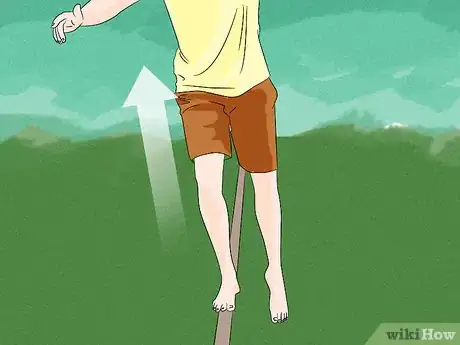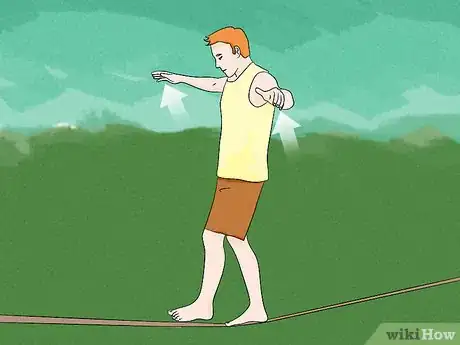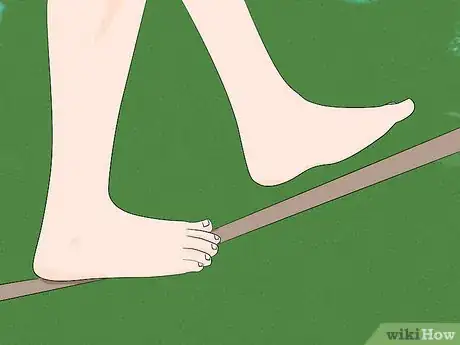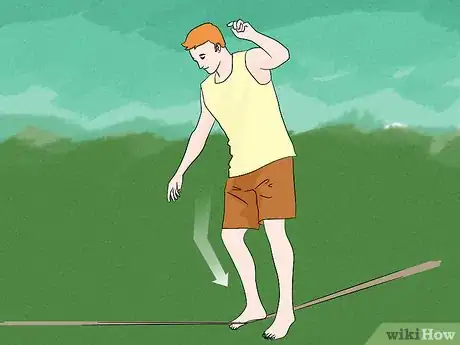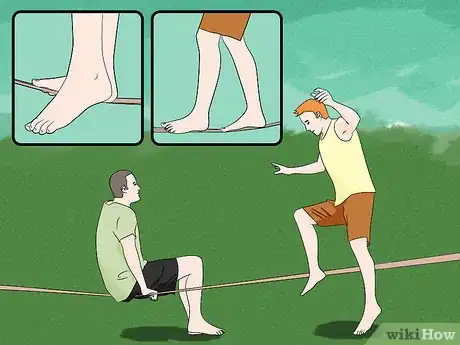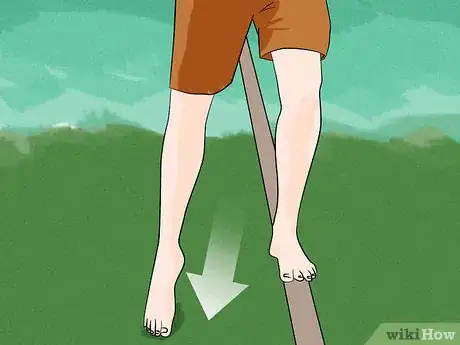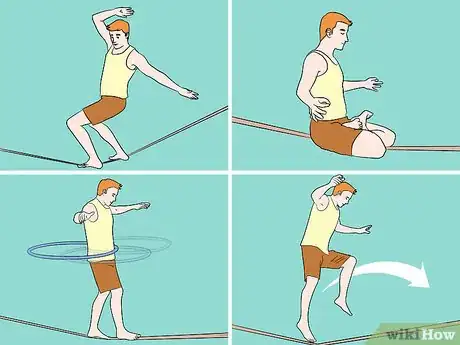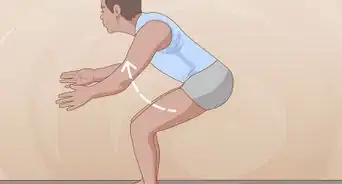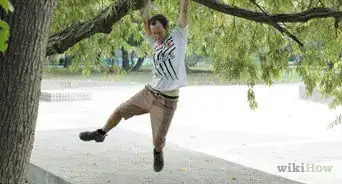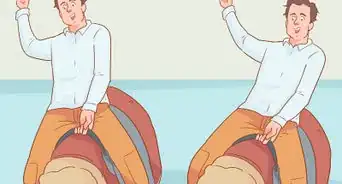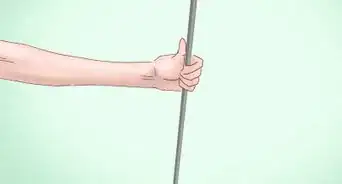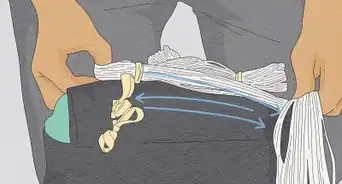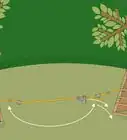wikiHow is a “wiki,” similar to Wikipedia, which means that many of our articles are co-written by multiple authors. To create this article, 41 people, some anonymous, worked to edit and improve it over time.
There are 9 references cited in this article, which can be found at the bottom of the page.
This article has been viewed 366,776 times.
Learn more...
If you’ve ever wanted to walk a tightrope high above the circus floor but got nervous just thinking about it, stack lining may be for you. Slacklining, an increasingly popular practice in the balancing arts, involves walking across a bouncy, highly-tensioned, single piece of webbing that may be only a couple inches off the ground. Most of us have an inner equilibrium that can enable us to perform extraordinary balancing feats, but getting up on the line can still be scary. Remember how intimidating it seemed to balance on a bicycle without training wheels? Now think how easy it turned out to be. Walking a slackline just takes confidence and a bit of practice.
Steps
The Basics
-
1Start with a short slackline. The shorter the distance between the two anchor points, the more stable the slackline. As the slackline gets longer, a few things happen:
- The tension in the line increases, making dismounts more dangerous due to the extra force;
- The height of the line off the ground increases to allow for greater sag when weighted;
- It requires more force to tighten it, which can be difficult with some tightening systems.
-
2Place one foot lengthwise in the middle of the slackline.
- Starting barefoot is a good idea. Using bare feet will allow you to feel the line better and find your balance more quickly.
- Step on the line so that it runs from between your big toe and second toe back to the middle of the heel. As you improve, practice turning your feet and standing sideways, with your shoulders parallel to the line.
- Once you improve (or if the landing is not safe for bare feet), you may want to switch to shoes since they provide greater protection when attempting tricks and landing.
Advertisement -
3You can mount the slackline at any point, but starting in the middle is generally safer, since it is usually away from obstacles you might hit when falling. The line is also lower to the ground in the middle once weighted, reducing the height of the falls.
- Practice from the same place each time since the slackline oscillates differently at different distances from the anchors. The wobbles are faster and smaller near the anchors and slower and larger near the middle.
- But wherever you start, it is going to wobble a lot. This is natural; everyone wobbles the first time.
-
4Take a couple deep breaths and settle yourself. If you are relaxed, your foot will be less shaky on the line.
-
5Focus intently on a single point, such as the anchor. This will help you find and keep your balance. Resist the temptation to look straight down at your feet on the line. Looking down at the wobbling line will simply make you wobble as well. Look ahead instead of down at the line.
-
6Put your arms out wide, slightly bent and keep an upright posture.
-
7Center your weight directly over the foot on the line. With one smooth, balanced motion stand up on that leg.
-
8Balance on one foot, while using your arms and other leg to help maintain your balance.
-
9Bend the leg that is on the slackline. Bending your leg lowers your center of gravity slightly, and allows you to more easily find your balance and absorb the movements of the line.
-
10Continue to wave your free arms and legs around to help you balance. Sometimes you will twist and turn your body into all sorts of positions to keep your balance.
- Once you have caught your balance slowly move your body back to center with your arms up and out, knee(s) bent, head up, and eyes focused on a single point.
-
11Repeat these steps until you can balance for at least 15 seconds.
-
12Practice with the other foot. Once you can keep your balance, attempt taking a step.
-
13Once you've successfully taken your first step, keep practicing!
Sample Skill Progression for Beginners
-
1These are small steps you can take to improve your slack lining effectively, by slowly taking on harder and harder tasks.
- Mount the line on one foot with a friend sitting on the line.
- Increase the distance between you and the person sitting on the line.
- Balance on one foot by yourself.
- Balance on the other foot.
- Balance with both feet, one behind the other, on the line.
- Take small steps forward.
- Take small steps backwards.
- Mount the line sideways (shoulders parallel to the line) with both feet, one at a time.
- Turn on the line.
-
2Additionally, learn how to fall safely.
- As a beginner you will likely be on a short, low-to-the-ground slackline. Most of the time you can land on your feet.
- As you try new tricks, the slackline can "throw" you as you lose your balance. The best solution is to use the "throw" of the slackline to help you get away from the line and land on your feet.
- If you are thrown off-balance from the line consider rolling through the fall to limit the impact.
-
3You can also try starting with "training wheels."
- One way to do so is to have a friend sit on the line a few feet away from you. This takes much of the sway and bounce out of the line. As you get better, have your friend move further away on the line to allow for more wobble.
- When starting out, you can aid each other while learning to balance--have a spotter stand/walk next to the line. If you practice walking back and forth with a shoulder to lean on, you’ll soon find that you don’t need training wheels any more!
Community Q&A
-
QuestionWhere can I get a cheap rope to use for this?
 Community AnswerYour local hardware store or leisure/hobbies store may stock cheap slackline rope.
Community AnswerYour local hardware store or leisure/hobbies store may stock cheap slackline rope. -
QuestionWhat thickness of rope do I need?
 Community AnswerSlacklines come in 1 inch and 2 inch widths. 2 inch line is good for beginners but not compulsory.
Community AnswerSlacklines come in 1 inch and 2 inch widths. 2 inch line is good for beginners but not compulsory. -
QuestionHow can I earn money from slacklining?
 Community AnswerFilm yourself and start your own YouTube channel, get subscribers, monetize through ad sponsorship, and voila!
Community AnswerFilm yourself and start your own YouTube channel, get subscribers, monetize through ad sponsorship, and voila!
Warnings
- Slacklines are extremely taut, so when you fall be careful how you land and try not to get hit by the line.⧼thumbs_response⧽
- Do not use slackline materials for climbing after they have been tensioned in a slackline.⧼thumbs_response⧽
- Remember to take things slowly, and be safe. Take necessary safety precautions.⧼thumbs_response⧽
- Even though slacklines may be only inches above the ground, falling off of one may lead to serious injury, depending on what is below the slackliner. Start off above a lawn or similarly soft ground. Try using pads or old mattresses to cushion your fall.⧼thumbs_response⧽
Things You'll Need
- Two anchor points
- A slackline
- Pulley, ratcheting mechanism, carabiners, or some other means of getting the line tight.


